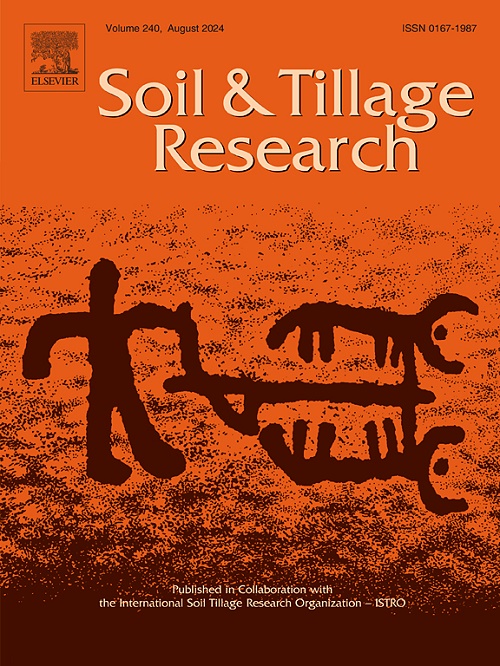微塑料对压实土水力特性和孔隙特性的影响
IF 6.1
1区 农林科学
Q1 SOIL SCIENCE
引用次数: 0
摘要
微塑料作为新兴的持久性污染物,已广泛分布于自然环境中。目前的研究主要集中在微塑料对未压实或轻度压实土壤的影响上。然而,微塑料对压实土壤的影响尚不清楚,需要紧急调查。因此,本研究以聚乙烯颗粒为微塑料,研究其对压实粘土的水力特性(饱和导水率、保水能力和水稳定性)和孔隙特性(孔隙率和孔径分布)的影响。随着微塑料浓度的增加,压实土的饱和水导率降低,保水能力和水稳定性增加。微塑料的加入降低了压实土的孔隙度,降低了团聚体间孔隙的体积,增加了团聚体内孔隙的体积。大孔(>4 μm)的百分比减少,微孔(<0.04 μm)的百分比增加。压实土水力特性的变化主要是由于微塑料改变了其孔隙特性。总的来说,大尺寸的微塑料比小尺寸的微塑料表现出更大的影响。与未压实或轻度压实的土壤相比,微塑料在环境相关浓度(0.5 wt%)下对压实土壤的性质有显著影响。本研究揭示了微塑料影响压实土水力特性和孔隙特征的机制,为微塑料污染对土壤环境的潜在影响和风险提供了见解。本文章由计算机程序翻译,如有差异,请以英文原文为准。
Effects of microplastics on the hydraulic properties and pore characteristics of compacted soil
As emerging persistent pollutants, microplastics have become widely distributed in natural environments. Current research primarily focuses on the effects of microplastics on uncompacted or lightly compacted soils. However, the effects of microplastics on compacted soils remain unclear and require an urgent investigation. Therefore, this study used polyethylene particles as microplastics to investigate their effects on the hydraulic properties (saturated hydraulic conductivity, water retention capacity, and water stability) and pore characteristics (porosity and pore size distribution) of compacted clayey soil. As the concentration of microplastics increased, the saturated hydraulic conductivity of compacted soil decreased, while the water retention capacity and water stability increased. The addition of microplastics reduced the porosity of compacted soil, decreasing the volume of inter-aggregate pores and increasing the volume of intra-aggregate pores. The percentage of macropores (>4 μm) decreased, while the percentage of micropores (<0.04 μm) increased. The changes in the hydraulic properties of compacted soil were mainly due to the alteration of its pore characteristics by microplastics. Overall, large-sized microplastics exhibited a greater impact than small-sized microplastics. In contrast to uncompacted or lightly compacted soils, the properties of compacted soils were significantly affected by microplastics at the environmentally relevant concentrations (0.5 wt%). This study reveals the mechanisms by which microplastics affect the hydraulic properties and pore characteristics of compacted soil, providing insights into the potential impacts and risks of microplastic pollution in the soil environment.
求助全文
通过发布文献求助,成功后即可免费获取论文全文。
去求助
来源期刊

Soil & Tillage Research
农林科学-土壤科学
CiteScore
13.00
自引率
6.20%
发文量
266
审稿时长
5 months
期刊介绍:
Soil & Tillage Research examines the physical, chemical and biological changes in the soil caused by tillage and field traffic. Manuscripts will be considered on aspects of soil science, physics, technology, mechanization and applied engineering for a sustainable balance among productivity, environmental quality and profitability. The following are examples of suitable topics within the scope of the journal of Soil and Tillage Research:
The agricultural and biosystems engineering associated with tillage (including no-tillage, reduced-tillage and direct drilling), irrigation and drainage, crops and crop rotations, fertilization, rehabilitation of mine spoils and processes used to modify soils. Soil change effects on establishment and yield of crops, growth of plants and roots, structure and erosion of soil, cycling of carbon and nutrients, greenhouse gas emissions, leaching, runoff and other processes that affect environmental quality. Characterization or modeling of tillage and field traffic responses, soil, climate, or topographic effects, soil deformation processes, tillage tools, traction devices, energy requirements, economics, surface and subsurface water quality effects, tillage effects on weed, pest and disease control, and their interactions.
 求助内容:
求助内容: 应助结果提醒方式:
应助结果提醒方式:


